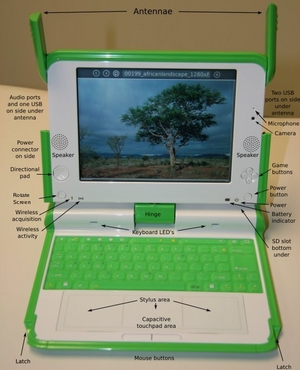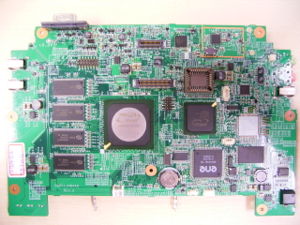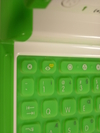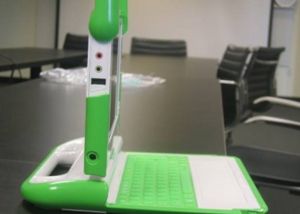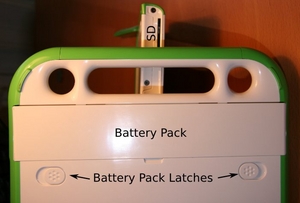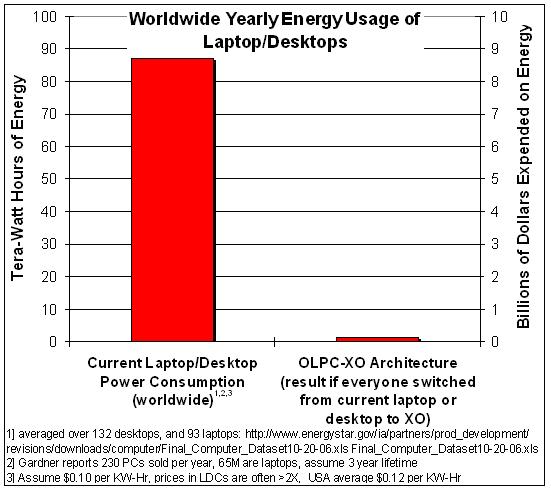Hardware specification
| deutsch | english | español | français | italian | 日本語 | 한글 | português | русский indonesia | HowTo [ID# 37798] +/- |
Contents
Laptop Hardware
The XO laptop is the center of One Laptop Per Child. After two years of development, it is approaching mass production, with several thousand Beta test (B2) units deployed to developers and for testing in schools in participating countries. The laptop design has just undergone a final minor update to keep up with advancements in technology.
Specifications
- Graphics Controller: Integrated with Geode CPU; unified memory architecture
Physical dimensions:
- Dimensions: 242mm × 228mm × 30mm (approximate, subject to change)
- Weight: Less than 1.5 kg (target only — subject to change)
- Configuration: Convertible laptop with pivoting, reversible display; dirt and moisture resistant system enclosure
Core electronics:
- CPU: AMD Geode LX-700@0.8W
- CPU clock speed: 433 MHz
- Compatibility: Athlon instruction set (including MMX and 3DNow! Enhanced) with additional Geode-specific instructions
- North Bridge: PCI and Memory Interface integrated with Geode CPU
- Graphics Controller: Integrated with Geode CPU, using a unified memory architecture
- South Bridge: AMD CS5536 (datasheet)
- DRAM memory: 256 MiB dynamic RAM
- Data rate: Dual – DDR333 – 166 MHz
- BIOS: 1024 KB SPI-interface flash ROM; LinuxBIOS open-source BIOS; Open Firmware bootloader
- Mass storage: 1024 MiB SLC NAND flash, high speed flash controller
- Drives: No rotating media
- Embedded Controller: ENE KB3700: File:KB3700-ds-01.pdf
Display:
- Liquid-crystal display: 7.5” Dual-mode TFT display
- Viewing area: 152.4 mm × 114.3 mm
- Resolution: 1200 (H) × 900 (V) resolution (200 dpi)
- Mono display: High-resolution, reflective monochrome mode
- Color display: 800 (H) x 600 (V) or greater transmissive color mode
- Power Consumption: 0.1 Watt with backlight off; 0.2-1.0 Watt with backlight on
- The DCON - Display Controller chip with memory that enables the display to remain live with the processor suspended. The display and this chip are the basis of our extremely low power architecture. The machine is usable and relaying mesh networking traffic while the CPU and much of the motherboard is regularly turned off. The display controller chip also enables deswizzling and anti-aliasing in color mode. You can examine this photograph of the display (it looks even nicer in person; photographing a display is remarkably difficult).
- Note: web browser images are currently scaled up so that an image of very roughly [800x600] fills up the browser window.
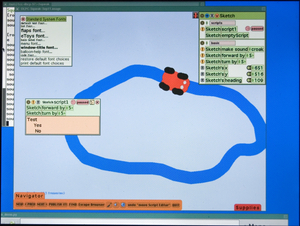
Integrated peripherals:
- Keyboard: 70+ keys, 1.2mm stroke; sealed rubber-membrane key-switch assembly
- Keyboard Layouts
- Layout pictures (for B3)- US International, Thai, Arabic, Spanish, Brazilian Portuguese, Nigeria, Urdu, French
- Cursor-control keys: five-key cursor-control pad; four directional keys plus Enter
- Touchpad: Dual capacitance/resistive touchpad; supports written-input mode
- Audio: Analog Devices AD1888, AC97-compatible audio codec; stereo, with dual internal speakers; monophonic, with internal microphone and using the Analog Devices SSM2302 for audio amplification
- Wireless: Marvell Libertas 88W8388+88W8015, 802.11b/g compatible; dual adjustable, rotating coaxial antennas; supports diversity reception
- Status indicators: Power, battery, WiFi; visible lid open or closed
- Video camera: 640x480 resolution, 30FPS
- Independent and undefeatable by software display of microphone and camera recording status
External connectors:
- Power: 2-pin DC-input, 10 to 20 V usable input. Input can safely handle -40 to 39 V. input. Exceeding this range will likely blow a one-time fuse.
- Line output: Standard 3.5mm 3-pin switched stereo audio jack
- Microphone: Standard 3.5mm 2-pin switched mono microphone jack; selectable input mode:
- Sensor, DC w. 2.5 V (3K ohm impedance) bias voltage for switches, resistive sensors, etc.
- Sensor, DC w. no bias voltage for measuring voltages (0 - 3 V)
- External Microphone, AC w. bias voltage
- Expansion: 3 Type-A USB-2.0 connectors; MMC/SD Card slot
- Maximum power: 1 A (total)
Battery:
- Fully-enclosed “hard” case; user removable
- Pack type: 4 Cells, 6V series configuration
- Two chemistries:
- NIMH, with a capacity of 16.5 Watt-hours
- LiFeP, with a capacity of 22 Watt-hours
- Electronics integrated with pack provide:
- Identification
- Battery charge and capacity information
- Thermal and over-current sensors along with cutoff switch to protect battery
- Cycle life: Minimum 2,000 charge/discharge cycles (to 50% capacity of new, IIRC).
- Power Management will be critical
BIOS/loader:
- Open Firmware is used as the firmware, including hardware initialization and fast resume.
Environmental specifications:
- Temperature: somewhere in between typical laptop requirements and Mil spec; exact values have not been settled
- Humidity: Similar attitude to temperature. When closed, the unit should seal well enough that children walking to and from school need not fear rainstorms or dust.
- Altitude: -15m to 3048m (14.7 to 10.1 psia) (operating), -15m to 12192m (14.7 to 4.4 psia) (non-operating
- Shock: 125g, 2ms, half-sine (operating) 200g, 2ms, half-sine (non-operating)
- Random vibration: 0.75g zero-to-peak, 10Hz to 500Hz, 0.25 oct/min sweep rate (operating); 1.5g zero-to-peak, 10Hz to 500Hz, 0.5 oct/min sweep rate (nonoperating)
- 2mm plastic walls (1.3mm is typical for most systems).
Regulatory requirements:
- The usual US and EU EMI/EMC requirements will be met.
- The laptop and all OLPC-supplied accessories will be fully UL and is RoHS compliant.
Laptop Development Schedule
The XO laptop hardware development schedule has two more test unit builds (Beta Test 3 and Beta Test 4), before a final test build (C Test 1) on the final production line and mass production. The Beta Test 3 build scheduled for early May will be the first one providing the processor and memory capabilities of the production version.
Pre-production Test Systems (CTest-1, or C1)
This build is a very small number (200 or so) of laptops produced as a test of the manufacturing process on the main production line, and should happen in early fall 2007. A C1 laptop is hopefully identical to a production unit in all aspects...
Beta Test 4 Systems (BTest-4, or B4)
This build, scheduled for the middle of summer 2007, is the final chance to fix hardware and mechanical problems that were detected in the Beta Test 3 build of the XO. Only a small number (200 or so) of these will be built for testing, as the injection molds for the plastic case have to be taken offline and duplicated to prepare for mass production (the Beta Test mold set will be retired after duplication).
No new features will be added to the laptop in this build. This build is planned merely to test solutions to problems detected in the BTest-3 laptops.
Beta Test 3 Systems (BTest-3, or B3)
This build, scheduled for May 2007, is the first to use an updated design for the laptop. Noticeable improvements over BTest-2 include:
- A faster, lower power processor: the Geode LX-700
- 64 KB I/64 KB D of L1 Cache, 128 KB of L2 Cache (vs. 32 KB of L1 cache)
- Faster processor and memory clock (433/333 vs. 366/266)
- 1.5 W typ. vs. 3 W typ.
- Much better graphics processor, including support for rotated blits and depth conversion
- More memory: 256 MB of SDRAM (vs. 128 MB)
- A new hinge design allows greater tilt of the screen
- An improved case design (addressing strength and water resistance)
A very small number of BTest-3 units (around a hundred) will be built, all destined for hardware and low level software development.
Beta Test 2 Systems (BTest-2, or B2)
Approximately 2500 systems were built by Quanta and are being distributed. These are fully functional machines with CaFE ASICs, and reflect some, but not all of the learning and improvements from testing of BTest-1. Much more information about the BTest-2 systems can be found in the BTest-2 Release Notes. Some of the details of the hardware design are to support the OLPC Human Interface Guidelines.
BTest-2 systems are almost identical visually with BTest-1. BTest-3 will have more substantial physical differences. An easy way to tell the difference between BTest-1 and BTest-2 is that BTest-1 keyboards have white lettering, and BTest-2 has black lettering.
Beta Test 1 Systems (BTest-1)
Approximately 875 systems were built by Quanta and were distributed. These are fully functional machines, but built before the rigorous testing that will now take place. Much more information about the BTest-1 systems can be found in the BTest-1 Release Notes.
Pre-BTest boards
A small number of pre-BTest boards were built in preparation for building complete BTest systems. Developer information about B-test boards are here.
Alpha Test Prototype Electronics
Power up of the first OLPC electronics prototype boards occurred April 15, 2006. Power and ground testing continued over the weekend, and formal debug and BIOS bring up started Monday, April 17, 2006 at Quanta Computer's labs in Taipei, Taiwan. By Wednesday, April 19, Linux was booting on the first generation prototypes.
Photographs:
- Component side OLPC circuit board
- Back side of the OLPC circuit board
- Picture of Linux running with circuit board in the lab
- Picture of the screen of Linux running on the OLPC circuit board; fittingly, it shows a Chinese desktop
Environmental Impact
How Green is my Laptop?
By Mary Lou Jepsen
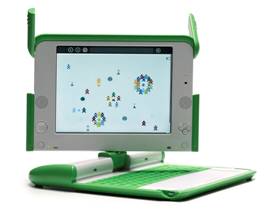
The XO by One Laptop per Child (OLPC) is not just visually green, it’s the most eco-green laptop ever made. Many would have you believe that buying “green” will cost more. This is true, for example, for hybrid cars. OLPC was unwilling to increase the price to go green, instead we concentrated on low-cost, low-power, long-life, and field repair and in so doing have created a stunningly green laptop.
OLPC is in process of filing for the first “gold” award that has ever been given to a laptop by EPEAT an organization that assesses the environmental impact of laptops according to the IEEE 1680-2006 specification. XO is also non-toxic and fully recyclable. We are planning a full take-back program. In other words: these machines are not destined for landfills at the end of their approximate 5 year lifetime. 2.5X the lifetime of a typical laptop.
If all computer users switched from their desktops and laptops to the OLPC XO laptop: $9B US dollars could be saved in world-wide electricity bills. This savings is enough to outright buy laptops for 50 million children. In addition, 50 million barrels of oil could be saved, and 65 million metric tons of environmental CO2 emissions could be avoided. In carbon-offset dollars for electricity use alone, another ~$500 million US dollars could be saved yearly.
E-waste
230 million personal computers are dumped in landfills every year. 500 shipping containers full of e-waste arrive in Nigeria everyday. The XO could lower the landfill impact in 4 key ways:
1)Longer Lifetime: The laptop lifetime is 5 years or 2.5 times longer than a typical laptop; even better: our batteries last 4X longer than typical laptop batteries. 2)Footprint: XO is half the size and weight of a typical laptop, and a fraction the size and weight of a typical desktop 3)Toxicity: XO is RoHS compliant: No chromium, lead, beryllium, mercury, cadmium and zinc are used on the motherboard or in the batteries. In addition, XO is one of the first laptops to eliminate mercury. This through the elimination of the small mercury-containing fluorescent lamp used in nearly all liquid crystal display. The OLPC display is one of the first to use LEDs in the backlight in lieu. 4)The OLPC recycling take-back program: For an additional $0.10 per laptop Quanta believes that they could institute a full take back recycling program. We are fully assessing the exact cost but are planning a full take back program to be implemented in each country.
Our goal: not a single XO laptop to end up in a landfill.
Power Consumption
Power consumption data for 132 desktop computers and 93 notebook computers which were averaged and used in this analysis . The average desktop computer idles at 80 Watts while the average laptop computer idles at 20 Watts. In contrast, the average idle power consumption of the XO laptop is just 1 watt.
Gardner reports that 230 million personal computers are sold per year, approximately 165 million of these are desktops and 65 million of them are laptops. Assuming 2000 hour use per computer per year at the low end of power consumption (idle-mode), and an average 3 year lifetime, 87 billion kilo-watt hours are used to power the world’s personal computers per year. If every personal computer was replaced by an OLPC XO laptop, just 1.5 billion kilo-watt hours would be needed: thus 85 Billion kilo-watt hours could be saved. Alternatively, the industry could just adapt a lower power consumption architecture like we have created. It allow human power recharge, and accepts solar power input, wind power, etc. At $0.10 per kilowatt-hour the savings of a massive switch to an XO or an XO like architecture amounts to a $8.5 billion dollar energy savings. And at 1700 kilo-watt hours per barrel of oil: 50M barrels, and 65 million metric tons of CO2 emissions or another approximately $500M yearly in carbon-offset dollars.
IEEE 1680 Consumer Electronics Environmental Impact
EPEAT has created a procurement tool to help evaluate, compare and select desktop computers, notebooks and monitors based on their environmental attributes. EPEAT provides a clear and consistent set of performance criteria for the design of products, and provides an opportunity for manufacturers to secure market recognition for efforts to reduce the environmental impact of their products. OLPC is in process of applying for a rating, which we believe will be excellent. XO appears destined to be the first laptop to receive their Gold Rating, it has even been suggested that the XO may warrant establishing a new, even higher rating. XO achieves the following which should give it the first gold award:
Notably - above and beyond the EPEAT requirements, XO has
•Batteries that last 4x longer than standard rechargeables •Power consumption at about 10% of typical laptop •Laptop lifetime of about 2.5x longer than typical (5 year life) •Half the size and weight of a typical laptop
Thus, above and beyond EPEAT, in our first year of deployment of 3–5M units we will save, when compared to any other EPEAT ranked laptop shipped in the same year, the following:
•45-million pounds of e-waste (3 lbs x 5 Munits x 2.5–4x lifetime/2000 lbs/ton) •240-Giga-Watt hours of energy (20 Watt extra x 8 hours x 300 days x 5M units)
As we scale in our second year of production these savings should increase even more: to preventing as much 500-million pounds of e-waste, and saving 2.5 Tera-watts of power. OLPC is working with other organizations to assure its environmental impact is very low and more information will be available here in the coming weeks.
See also
Formerly part of this page:
School Server Hardware
While the laptop is rightfully at the center of OLPC, a valuable peripheral is the school server. OLPC will be building and distributing school servers along with the laptops, to extend the storage and computation provided by each laptop, as well as providing a local library and a mesh portal to the Internet.
Unlike the laptop, the school server is more of a collection of services than a hardware platform. In a manner identical to the laptop, OLPC will collaborate with manufacturing partners to provide a cost-efficient hardware platform for running the recommended software. Unlike the laptop, the manufacturing collaboration will not be exclusive. Individual countries will be free (even encouraged) to design and manufacture their own school servers running derivatives of the OLPC school server software.
XS
This will be the school server built for OLPC by Quanta. It is still in the very early stages of design, but should reach early production volumes in late fall. See the specification.
XSX
This is a prototype school server, built for early school trials in country. It will be integrated from off-the-shelf components, and will be overpowered compared to a production school server in order to simplify early demands for system software. See the specification and the implementation.
